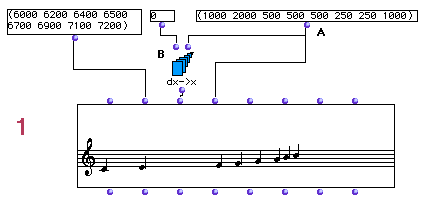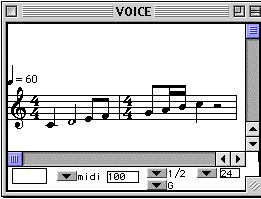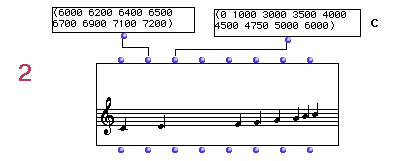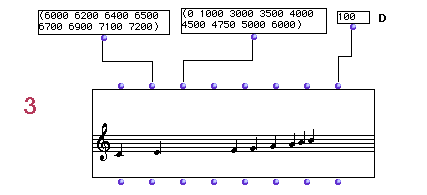OpenMusic Tutorials
Prev| Chapter 8. OM Music objects Chord-seq and Voice| Next
Tutorial 22: Chord-seq: Onsets and durations I
Topics
Managing durations in the Chord-seq editor
Key Modules Used
The Concept:
In traditional music notation rhythm is represented as a single value (quarter note, eighth note, etc…). These values don’t tell the whole story, however. The duration alone is not sufficient information when trying to place notes in time. One also needs to know when in time these values happen. Metric information consists then of two quantities:
Onsets are the ‘time addresses’ of events. An onset represents the absolute location of the beginning of a note measured from a fixed point, the beginning of the sequence. In OM, onsets are always measured in milliseconds.
Durations are the lengths of these events. A duration represents the absolute length of note measured from the onset. In OM, durations are always measured in milliseconds.
The Patch:

Let’s take the following list of durations:
(1000 2000 500 500 500 250 250 1000)
Which, if transcribed, could be represented by the following:

We will take this list of durations and connect it to the _ldur_ input of a
Chord-seq. These durations have to be converted into
onsets relative to the beginning of the sequence before they are given to the
_lonset_ input. For this we use dx->x, which requires us to
tell it the absolute starting point, which in this case is 0ms, the beginning
of the sequence. This produces
(0 1000 3000 3500 4000 4500 4750 5000 6000)
which we pass to the Chord-seq.
In example 2,

we will use this same list of onsets (C) as produced by dx->x.
We will not specify anything at the duration input. This will result in
‘wrong’ duration values, i.e all notes defaulting to a length of 1000
milliseconds. The sequence will thus have gaps or overlaps, as you can verify
in the editor:

Rather than calculate the durations, we can fix this by using the _legato_
input. The legato input overrides the default durations. It is a value
representing a percentage of the perfect legato, with every note ending
exactly as the next note starts. If we enter 100 here we fix all the durations
of the sequence, as we’ve done in example 3:

Alternately, we could use the function x->dx to turn the list
of onsets into a list of durations.
Prev| Home| Next
—|—|—
OM Music objects Chord-seq and Voice|
Up| Tutorial 23: Chord-seq: Onsets
and durations II